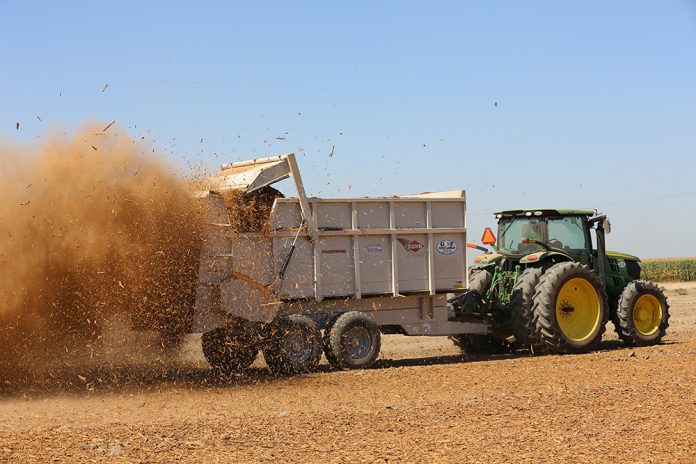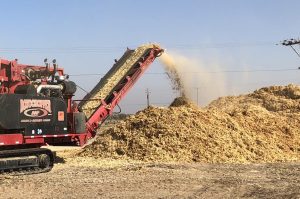
Fifteen years after orchard burning restrictions were initiated and demand for cogeneration materials slowed, a solution, whole orchard recycling (WOR), has become standard practice for many orchard removals.
Along the way, the WOR process has been refined, re-evaluated and incentivized. UCCE Farm Advisor Brent Holtz, the lead researcher in WOR, said the practice continues to be refined and benefits confirmed in trials of second-generation trees. According to the California Air Resources Board, more than 100,000 acres of almond trees and 10,000 acres of walnut trees have been pulled, chipped and returned to the soil. Holtz noted WOR is a more expensive option for orchard removal, but the long-term benefits to orchard and soil health are becoming evident.
Over the years, trials in almonds have proven that WOR increases soil organic matter, increases soil carbon, increases soil nutrients and soil microbial diversity. Water holding capacity is increased with WOR as is orchard productivity.
Whole orchard recycling involves uprooting the trees, grinding them into wood chips and spreading the chips over the former orchard floor. After incorporating the chips into the soil, the process of preparing the site for a new orchard begins.
Josette Lewis, chief scientific officer for Almond Board of California, said there is no other orchard management practice that puts that much organic matter into the soil at any one time and has a dramatic impact on soil quality.
New Findings in WOR
One of the more significant and recent findings with WOR research is a reduction in nitrate leaching. A report published in the Journal of Environmental Quality in 2022 showed the effects of WOR on nitrate leaching potential. Unhealthy nitrate levels in groundwater in the San Joaquin Valley have been blamed on inefficient nitrogen fertilization and irrigation. A research team found in the short term, biomass recycling led to N immobilization within the orchard biomass incorporation depth zone of 0 to 15 cm without impacts on N leaching potential. The team concluded the practice of WOR reduced nitrate leaching potential by 52% 10 years after biomass incorporation without an increase in N mobilization. Results of this trial, the team concluded, highlight the potential of WOR to mitigate nitrate discharges into groundwater while conserving soil resources.
The immobilization of N, an effect of adding the carbon, was realized early on in WOR trials, and it was initially recommended to growers who were replanting trees to increase nitrogen fertilization from three ounces per tree to five ounces the first year after planting. Due to returning 40 to 50 tons of carbon per acre to the soil, the C to N ratio is thrown out of whack. The soil microbes respond to the abundance of carbon and deplete the N, leaving new tree deficient. New findings by Holtz and UCCE advisor Mae Culumber showed the deficit is short term. Early fertilization and better root zone placement may mitigate the need for additional nitrogen. By the second year after planting, enough soil microbes are cycling to release sufficient N back to the soil.
Early on in WOR trials, there were concerns with perpetuation of diseases and lack of equipment to meet demand. There was experimentation with different types of tree grinders, debates on whether to just spread the chips on top of the ground or incorporate them into the soil. There were questions about the depth chips should be incorporated and the rate per acre.
Holtz said the disease issue has been a problem for second-generation WOR orchards. Many diseases are spread by roots, and although trees are removed by uprooting, some root material will remain in the ground. Holtz explained the wood chips incorporated into the soil are decomposed by the microflora in the soil along with most pathogens. If wood debris in contact with soil stays moist, it is rapidly colonized by fungal mycelium that incorporates woody material into soil aggregates.
In addition, he said there is evidence that some soilborne pathogens, like Phytophthora, have cellulose in their cell walls, and like the cellulose in the wood chips, it is broken down by the soil microflora. Holtz said he suspects it could also be the case with other diseases. A nematode species of the family Tylenchidae feeds on algae and fungi and is not parasitic to trees. Holtz said during trials, significantly greater Tylenchidae were observed in the grind plots, especially next to woody pieces.
Whole orchard recycling does not prevent replant disease, but Holtz said the additional soil nutrients, increased water holding capacity and biodiversity present will help new trees to withstand disease pressure.
Due to availability of financial incentives, Zack Fowler of Fowler Bros. Farming in Waterford, Calif. said most almond growers who are considering orchard removal have chosen to go the WOR route. Pulling and chipping trees and spreading the chips is the basic procedure and runs about $1,000 to $1,500 per acre. Complete removal, chipping, spreading and groundwork including fumigation plus an irrigation system comes at a higher cost in the $7,000- to $10,000-per-acre range. Fowler said most orchard sites can be turned around in three to four months.
The WOR process has remained pretty much the same over the years, Fowler said. The horizontal tree grinders produce 3- to 4-inch chips. Vertical beater spreaders are an improvement in spreading chips as they can do a more even job across the orchard site. This is a huge consideration, Fowler said, as uneven spreading means where the chip layer is thicker, the chip decomposition process is considerably slower. And if the wood chips are not spread properly, tree stunting can occur in the replanted orchard.
After chips are spread, Fowler said the site is ripped in two directions and then disced, incorporating the chips into the soil. Fumigation can be done then if needed and tree berms formed.

Incentives
Holtz reports that due to incentives, the number of WOR providers has increased in recent years partially due to higher demand.
WOR is eligible for co-funding through CDFA’s Healthy Soil Incentives program and the USDA-NRCS Conservation Stewardship Program. San Joaquin Valley growers can receive cost share funding through the Alternative to Agricultural Open Burning Incentive Program. Growers participating in this program are eligible to receive $300 to $600 per acre, with a maximum of $60,000 per grower. Incentive recipients are typically paid four to six weeks after their completion of WOR, and after an invoice has been sent to the district.
In addition to the application forms, the district requires an itemized quote from the service provider, detailing the work planned and a confirmation of the crop and acreage. There is a pre-inspection of the orchard or vineyard site.
After an application is approved a district voucher will be issued. The grower has 180 days from the date on the voucher to complete the project. There will be a post-inspection site visit from district staff, once the inspection is completed and meets requirements, payment will be issued.

Cecilia Parsons | Associate Editor
Cecilia Parsons has lived in the Central Valley community of Ducor since 1976, covering agriculture for numerous agricultural publications over the years. She has found and nurtured many wonderful and helpful contacts in the ag community, including the UCCE advisors, allowing for news coverage that focuses on the basics of food production.
She is always on the search for new ag topics that can help growers and processors in the San Joaquin Valley improve their bottom line.
In her free time, Cecilia rides her horse, Holly in ranch versatility shows and raises registered Shetland sheep which she exhibits at county and state fairs during the summer.















